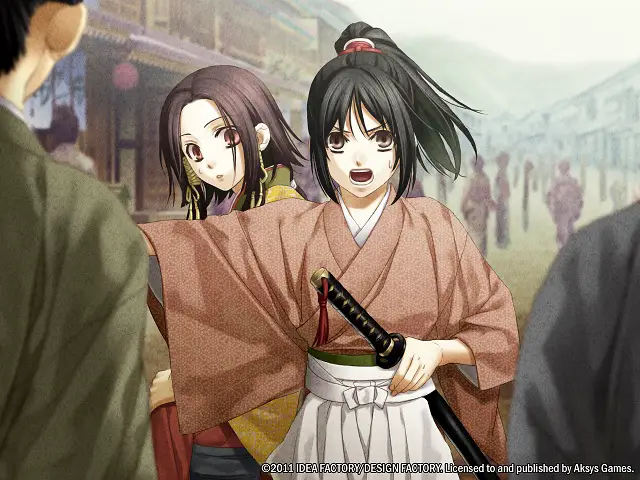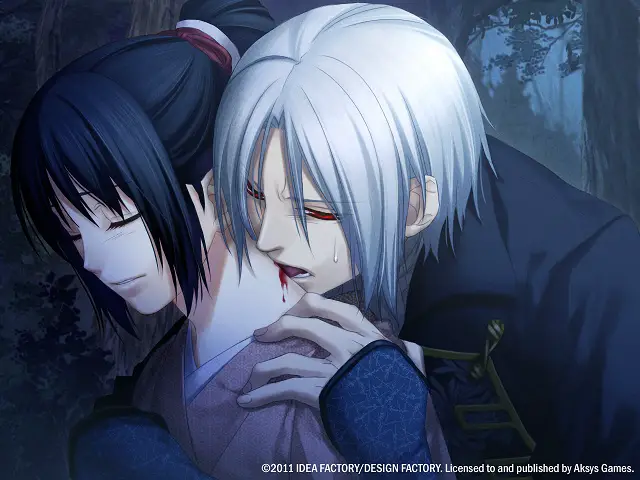With the Vita’s release quickly approaching, one has to wonder what went through Aksys Games’ mind when it announced that it was publishing an otome visual novel game for the PSP. Will Hakuoki: Demon of the Fleeting Blossom be successful at showing that the PSP still has life in it? Or will it be just a fleeting reminder of why otome titles don’t make their way stateside often? I had the chance to play Hakuoki and I will admit that the otome-loving gamer in me was looking forward to playing a portable visual novel.
A first glance at Hakuoki: Demon of the Fleeting Blossom‘s box art will have you wondering if it truly is an otome title. Once you start playing, it becomes clear that you are playing a visual novel that doesn’t heavily rely on the romance factor as much as it does the action and historical parts. The premise of the game is that you play as Chizuru Yukimura, a young lady who travels to Kyoto during the Edo Period in search of her missing father. It is during her trip that she runs into the Shinsengumi who save her from white-haired men intent on killing her. This incident leads Chizuru into residing with the Shinsengumi men as they work together to find her father. Many secrets are uncovered during this period, some regarding the Shinsengumi, and even ones about Chizuru herself.
As with most visual novels, Hakuoki relies on anime-style portraits of the characters and beautifully drawn images during key scenes. Each of the characters are unique in their appearance. The text is easy to read and stands out against the parchment windows or black background. Animations are limited to the symbol in the top right corner when you fast forward and the blossom petals that appear in front of a character’s portrait when you raise their romance meter. The menus can be accessed with push of a button. They are easy to navigate and the inclusion of the title’s encyclopedia is great for providing background information on many of the figures and locations from the time period. There is a gallery and theater for you to view unlocked images and videos.
The music is beautifully orchestrated and really give off the perfect vibe, whether it’s an endearing moment or a suspenseful one. Though the script has been translated, the vocal track is Japanese. Those who are hoping to have English voices to go along with the text will be disappointed. I felt that the lack of an English vocal track didn’t hinder my fun with the game, though. The Japanese voice actors do a fantastic job at giving the characters emotion. The sound effects for the sword fights and moans/groans of pain from being attacked are well-done and add to the reason that Hakuoki is rated M.
Hakuoki: Demon of the Fleeting Blossom plays out just like any otome title. When you first start the game, you go through the prologue. Each playthrough remains on the same course for the first three chapters. The fourth chapter is where the story will branch off and follow events that focus on the character with the highest romance level. Though making the right choices will increase the level of romance of a character depending on the scene, choosing one that is against the favor of the character you are interacting with has no negative effects. Pressing the X button moves the story forward at normal pace, whereas the square button will fast forward through the previously seen text. The circle and triangle buttons remove the text windows and access the menu, respectively. One feature that can prove to be really helpful when you play through trying to romance the character of your choosing is the ability to press the L1 button to auto-save. The R1 button brings up the confirmation to load the auto-save in case you decide to alter your choice along the story.
The prologue serves to introduce Chizuru Yukimura and how the Shinsengumi rescued her. Things look grim for Chizuru as the group of men debate if they should kill her for stumbling on a secret of theirs. But when it comes out that they were mistaken by her gender (due to her dressing in men’s clothes to make traveling easier) and that she is looking for her father whom they are searching for as well, the group decides to let her stay within the confines of the headquarters. As time passes, Chizuru gains the trust of each member. The story, overall, was good, and had me learning new things about Edo Period Japan and key people from this time period. Though the basis of the story and the cast are from history, Hakuoki adds a supernatural twist to it. When Chizuru first encounters the white-haired ronin who lust for blood, it’s clear that they are not human. As the story progresses, Chizuru and the clan meet a group of men who claim to be demons and have the superhuman strength to back up their claims. When the story does branch off, it still follows the same storyline in each branch. However, you view key moments in different ways. In one character branch, you will bypass certain battles/scenes. While in another character’s branch, you can be in the front of the action. Hakuoki is action-packed but still plays like a visual novel. Key action scenes are accompanied by artwork that either shows swords drawn for attack or the aftermath and the sounds of swords slicing through the air and the groans of the victims.
Each of the members of the Shinsengumi are based on actual members of the group of the same name. They also stand out from one another with their personalities and appearance. You have the cynical Okita, who mentions numerous times that if Chizuru steps out of line he’ll kill her, to the more reserved and loyal member to the Shinsengumi, Saito. With their varying personalities, the group really fits in and works well together. The level of comradeship they share is tested throughout the game by enemies and even ones they consider family. There are parts in the story that explains well certain characteristics depending on which character branch you are on. It is during this part of the game that I felt that Chizuru was able to get closer to the members.
Hakuoki does track how long you play, resetting once you fully complete the storyline and start anew. I noticed that the time does stack when you pick places in the Record of Service that lists each chapter you have completed in a nice and organized fashion. My first playthrough took roughly four hours. To view every ending available in Hakuoki: Demon of the Fleeting Blossom, it could take at least 40 hours. This amount will vary depending on if you keep track of the outcome of each choice you have to make in the game. Each character route you take, or ending you aim for, will vary in time to complete. Though this does seem like a short amount of play time, the multiple endings do boost the time you can spend on the title. However, this is only good if you are interested in unlocking all the images/videos and want to see each ending.
Otome fans and Hakuoki fans will enjoy this portable visual novel. Don’t be fooled by its classification in the otome genre; Hakuoki: Demon of the Fleeting Blossom isn’t all about romance and will appeal to those who like some action in their visual novels. While the target audience for this sort of title is small here, if you enjoy reading books and/or listening to audiobooks, this is worth picking up. It also makes me hope to see more otome genre games make their way onto the portable consoles and home consoles.
|
Hakuoki: Demon of the Fleeting Blossom
|
||
|---|---|---|
 |
Platform: PSP Genre: Otome, Visual Novel Release Date: February 14, 2012 Developer: Idea Factory Publisher: Aksys Games ESRB Rating: M MSRP: $39.99 |
|





